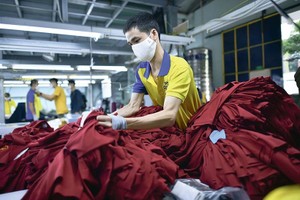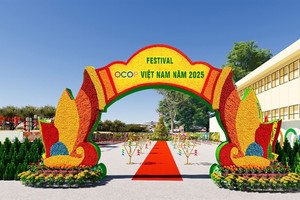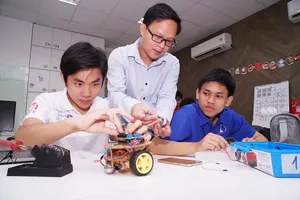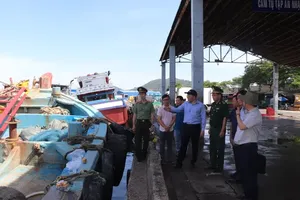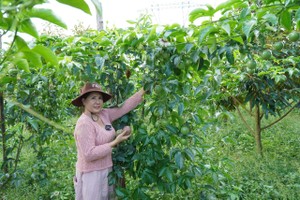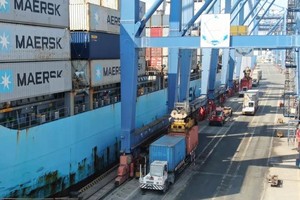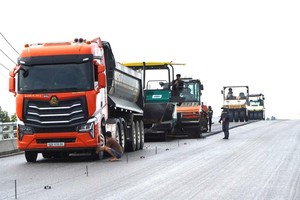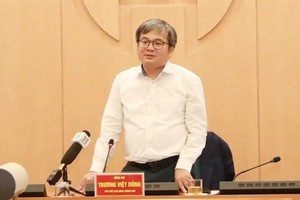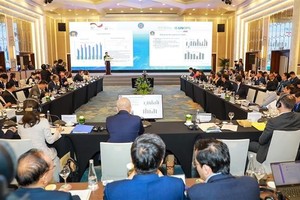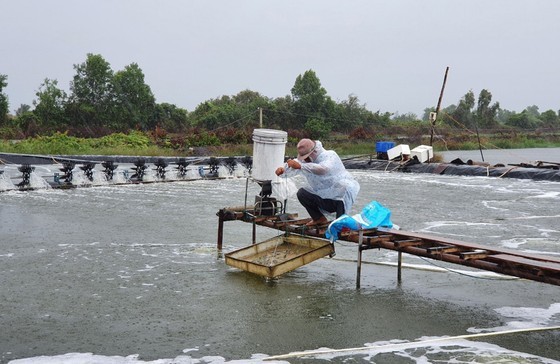 |
Kien Giang farmers increase investment in shrimp farming models. (Photo: SGGP) |
Over 15 years ago, some farmers from Bac Lieu and Ca Mau provinces began cultivating shrimps on Vinh Thuan alkaline soil in Kien Giang Province. They converted fields of weeds and grass into canals and ponds for shrimp farming, and it took approximately 5-6 years for shrimp farming to become stable in the area.
An assessment by the Ministry of Agriculture and Rural Development indicates that there has been a significant improvement in the awareness and administrative capacity of local authorities, businesses, and individuals to fulfill their roles and responsibilities. This progress reflects a broader shift in Vietnam's agriculture sector from traditional agricultural production to a more dynamic agricultural economy. This is also the general direction for the development of the agriculture sector.
Well-off thanks to shrimp farming
Mr. Vo Van Luong, 56, Director of Yen Loi Shrimp-Rice Cooperative in Nam Yen Commune, An Bien District, Kien Giang Province, recalls the challenges faced by coastal farmers about ten years ago. They had to wait for the first rains of the rainy season to sow rice in their fields and anxiously waited for the next showers for the rice seeds to germinate and for the young green color to gradually cover each patch of land. Unfortunately, in some years, saltwater intrusion caused the rice seedlings to die, forcing farmers to sow rice again 2-3 times. Farmers who were poor and too depressed abandoned their fields and worked as hired laborers while waiting for fresh water in the winter-spring crop to return to growing rice.
Not only farmers in An Bien but those in Vinh Gia Commune (Tri Ton District, An Giang Province), Vinh Dieu, Phu Loi, Phu My communes (Giang Thanh District), An Minh and Vinh Thuan districts (Kien Giang Province) also suffer from that precarious and risky situation.
Mr. Le Trung Ho, Secretary of the Vinh Thuan District Party Committee, revealed that over 15 years ago, farmers from Bac Lieu and Ca Mau provinces began cultivating shrimp on the alkaline soil of Vinh Thuan. They transformed fields of weeds and grass into canals and ponds for shrimp farming, and it took approximately 5-6 years for shrimp farming to become stable in the area. Some people who could not endure the challenges left their homeland, while those who stayed persevered and eventually turned shrimp farming into a prominent economic sector alongside rice cultivation. People in the U Minh Thuong area often humorously say that "shrimp embraces the rice plant."
We recently revisited Binh Dai District in Ben Tre Province, the area that was hit hardest by saline intrusion in 2016 and 2020. During our visit, we spoke with Phan Van Queo, a shrimp farmer in the district, who explained that the situation had changed. In fact, the saltier the water, the better the conditions for shrimp farming. With modern farming techniques, farmers now worry that the water may not be salty enough to raise healthy shrimp. Surprisingly, higher salinity levels actually result in lower farming costs.
Assoc. Prof. - Dr. Le Anh Tuan, a leading professor in the Faculty of Environment and Natural Resources and former Deputy Director of the Institute of Climate Change Research at Can Tho University, has noted that in recent years, technical training and increased awareness of environmental protection and sustainable development have led to the improvement and integration of non-structural projects in the national target program on climate change. These projects are distributed widely, taking into account regional ecological factors and people's livelihoods related to coastal agriculture, forestry, and fishing, as well as mangrove ecology, freshwater aquaculture, rice cultivation, and other handicrafts associated with freshwater ecosystems. Initially, the project plans focused mainly on protecting livelihoods, such as by building freshwater storage facilities in low-lying areas and protecting infrastructure and homes from flooding.
A noteworthy development is that farmers have shifted from monoculture rice production of 2-3 crops to multi-crop production in all three ecological zones, including freshwater, brackish water, and saltwater. This shift has resulted in higher profitability while maintaining at least one rice crop during the rainy season.
Agricultural production model conversion
Mr. Le Huu Toan, Deputy Director of the Department of Agriculture and Rural Development of Kien Giang Province, stated that the locality has gradually converted the crop structure on 5,119 hectares of rice land following the decision of the Ministry of Agriculture and Rural Development. This includes 1,431 hectares of annual crops, 804 hectares of perennial crops, and 2,080 hectares of rice combined with aquaculture. By the beginning of 2023, 11 out of 12 districts and cities in the province have implemented the restructuring of crops on inefficient rice-growing land. Through this conversion, farmers have shifted from growing two rice crops to one rice crop and one shrimp crop, as well as growing vegetables and taking advantage of the sea surface to raise mollusks, such as blood cockles and green mussels, which has brought in higher profits. The conversion has also improved soil quality, increased productivity, and reduced pests on crops, which is suitable for the ecological characteristics of each sub-region.
 |
Shrimp-rice farming model in Ca Mau adapts to climate change. (Photo: SGGP) |
The Department of Agriculture and Rural Development of Kien Giang Province reports that, on average, the converted areas achieved an economic efficiency 2.5-4 times higher than before the conversion. The crop rotation model generates an additional profit of VND15-25 million per hectare, while the specialized farming model brings in an additional profit of VND35-45 million per hectare. The conversion to growing fruit trees creates an increased profit of VND55-65 million per hectare. On the other hand, converting from specializing in rice cultivation to growing rice combined with aquaculture in suitable areas results in an average profit increase of over VND85 million per hectare per year. This combination model provides high economic efficiency and sustainability and is being considered for expansion to the U Minh Thuong districts and coastal areas of the Long Xuyen Quadrangle.
After changing their production mindset and models, farmers in various localities have significantly increased their incomes. For example, Nguyen Hoang Phi, a 62-year-old resident in An Minh District, Kien Giang Province, recently harvested over 1.2 tons of giant freshwater shrimp from his 5-hectare rice field, earning nearly VND130 million in profit. In addition to this shrimp crop, he also earned income from black tiger shrimp, white-leg shrimp, freshwater crabs, and wild freshwater fish, bringing in more than VND400 million per year. Phi converted his entire rice cultivation area from two crops per year to one shrimp crop and one rice crop combined with crab farming. "Thanks to converting to shrimp and crab farming, I can afford to raise my children. In this hamlet and commune, everyone has escaped poverty and become wealthy thanks to conversion and adaptation to new conditions," Phi said.
The North Ca Mau area, including Thoi Binh, U Minh, and a part of Tran Van Thoi districts, is located far from the estuary, resulting in freshwater during the rainy season and salty water during the dry season. Therefore, people raise shrimp during the dry season and grow rice during the rainy season while also interspersing with giant freshwater shrimp, black tiger shrimp, and fish.
Vo Hoang Linh, a resident of Bien Bach Dong Commune in Thoi Binh District, Ca Mau Province, shared that, for many years, his family had maintained the rice-shrimp production model. When using this model, he never uses chemicals or pesticides, leading to low costs and fewer diseases. Additionally, shrimp and rice complement each other. The decomposed rice stubbles serve as a food source for the shrimp, and the roots of rice plants absorb and clean the soil environment for shrimp.
Similarly, in the Northern area of the National Highway 1A in Bac Lieu Province, including Hong Dan, Phuoc Long districts, and Gia Rai Town, more than half of the aquaculture area, equivalent to about 70,200 hectares, is dedicated to the rice-shrimp rotation model.
Sau Ngoan, also known as the "shrimp king" of the Mekong Delta and a resident of Bac Lieu City, emphasized the need to be flexible and adapt to climate change. When encountering a saltwater environment, local people raise shrimp and fish and plant suitable crops.
The Department of Agriculture and Rural Development in Thoi Binh District, which has the largest rice-shrimp production area in Ca Mau Province, reports that the efficiency of the rice-shrimp production model in the area has been gradually increasing year by year.
For instance, the average rice yield has risen from 3.8 tons per hectare in 2013 to 4.8 tons per hectare in 2021. The productivity of black tiger shrimp alone has doubled from traditional extensive farming to improved extensive farming, reaching 320 kilograms per hectare. According to statistics, the average income from the rice-black tiger shrimp model is above VND65 million per hectare per year, 2-3 times higher than the rice-specializing model.
According to the Department of Agriculture and Rural Development of Bac Lieu Province, the rice-shrimp production model has shown a high initial efficiency compared to rice monoculture. As a result, the rice-shrimp production area has grown rapidly from 5,850 hectares in 2001 to 39,500 hectares in 2021, an increase of almost 6.8 times over the past two decades. Farmers adopting this model have reported an average income of over VND90 million per hectare with a profit of VND40-60 million per hectare per year.
